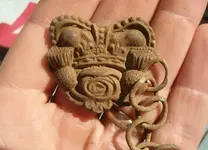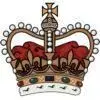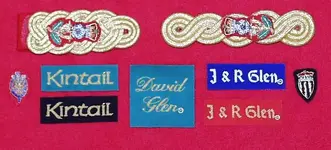I'm tracking down a research thread on this one but I'll go out on a limb and say its from the Fassifern sub-clan of the Cameron Clan, The "Fassifern" have the Rose and Thistle motif on their badge. Since it was found in Canada any chance it could be from a Highland Regiment fighting in the French and Indian Wars 1756-67:
Captain Alexander Cameron, 4th of Dungallon (c1730-1759) - a Jacobite whose father Alexander (3rd of Dungallon) had been a major in Cameron of Lochiel’s and Standard Bearer to the Prince [Muster Roll of Prince Charles Edward Stuart’s Army 1745-46], while Alexander Jr served as an ensign. Gazetted a captain on July 21, 1757 commanding one of three newly-authorized Additional Companies that joined the regiment whilst in Connecticut winter quarters April 1758; he was chosen to command a 100-man light infantry company in Halifax for the Louisbourg expedition, drawn from the best men of the three Additional Companies left at Halifax and assigned to Major George Scott's Provisional Light Infantry Battalion. He was one of four field officers assigned to the Garrison of Fort Stanwix, the winter of 1758/59. Dungallon died of a fever on September 3, 1759, ten days before the battle of the Plains of Abraham, and was buried at the Levis camp. An extant letter from Fassifern's son Lt Donald Cameron to his brother Ewen, refers to Dungallon's death. "... the very Day that I arived here which was the 3 of September Dungalon dyed. I came time Enough to see him Intered and that was all. Hew Cameron who is now Capt took care of all his things..." His body was later removed and re-interred at Quebec, and a monument to his memory was erected by John Nairne and Malcolm Fraser, brother officers who had served with him in the 78th's light infantry company. Ian McCulloch confirms that it was the son who died at Quebec, identified as the father in The Camerons, A History of Clan Cameron, by John Stewart of Ardvorlich (Jamieson & Munro Ltd., 1974, p. 219).
Lieutenant Donald Cameron (c1741-1817) - s/o John Cameron of Fassifern & Jean Campbell of Achalader - nephew of Lochiel; gazetted a lieutenant on September 30, 1758 in the 14th Additional Company; listed by Harper as a lieutenant among the officers who sailed for Louisbourg in 1758 [Appendix C] for the siege and capture June-July, 1758; fought at battle of Plains of Abraham on Septemer 13, 1759; wounded at Sillery on April 28, 1760; retired as a lieutenant in Captain Alexander MacLeod's company on half-pay in 1763. Major-General Stewart states that he “died a lieutenant on half-pay in 1817". Lieut Donald Cameron, yr of Fassifern (c. 1741-1817) - 78th Foot (Frasers Highlanders)










